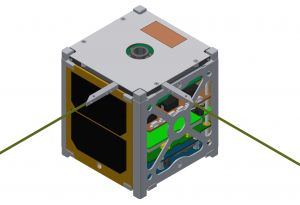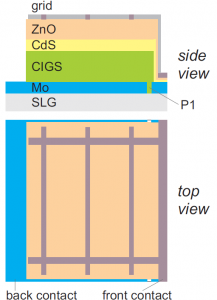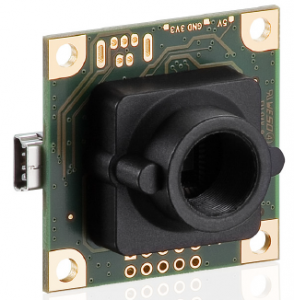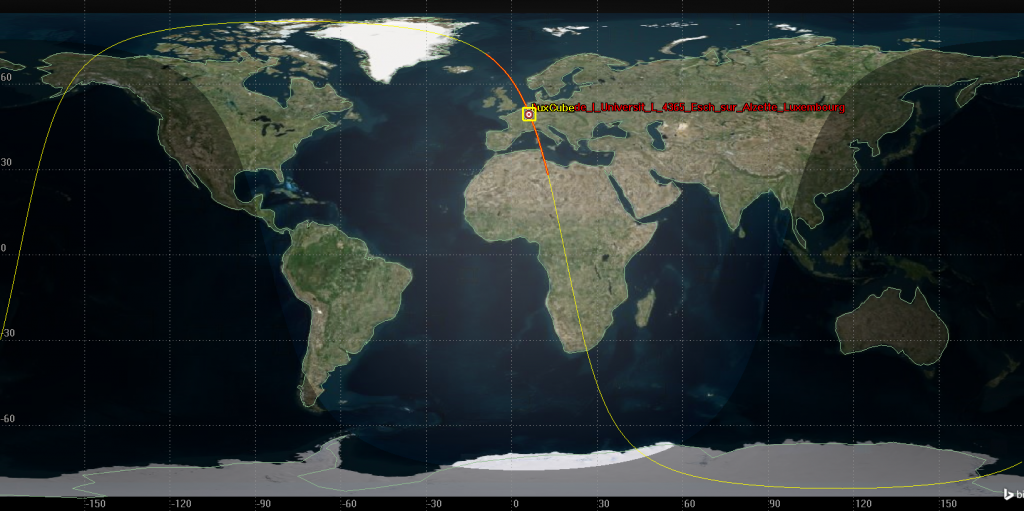Satellite description
Communications: LuxCube’s communication system consists of ISIS UHF downlink/VHF uplink full duplex transceiver with its corresponding ISIS deployable monopole antenna system. It has its own PCB and will be able to transmit and receive data at a rate of 9600 bps. LuxCube’s receiver will permanently operate to allow communication to the satellite. To manage the power budget the transmitter will be operational only during the time the spacecraft will be visible to the ground station. During this time, data will be transmitted to a ground station in Luxembourg.
Attitude determination and control: LuxCube will be equipped with a NewSpace Systems ACS board. This board comprises three sun sensors, a magnetometer, MEMS gyros for determination and magnetorquer rods for control. These components will allow to LuxCube a pointing knowledge error of 2° and a pointing accuracy error of 10° (eclipse: 20°). The magnetorquers will be used to detumble the satellite and to provide the required pointing accuracy to the camera and for data transmission when flying over Luxembourg. The magnetorquers of the ADCS will be tuned, by using the earth’s magnetic field, in a way that the camera points during the passes over Luxembourg.
Electric power system: Solar energy will be collected through five DHV Technology DHV-CS-10 solar panels. The energy will bed stored in a high energy density battery array EXA BA0x Irvene Class BA02/S. The battery is very light and allows an energy storage of 19,9 Wh.
On-board data handling: The subsystems will be connected to the CubSat Kit motherboard. The on-board computer and a SD-card will store data from the subsystems and the payload. The microchip will be used to control the Communications and ADCS systems. To reduce the amount of data transmitted from the satellite, the images taken with the camera will be compressed before sending them back to the ground station.
Thermal: MicroElectroMechanical System (MEMS) thermal sensors will be placed in diverse subsystems (batteries, solar cells, structure, etc.) and connected to the motherboard to monitor the temperature of the space hardware.
Structure: The selected structure is provided by Pumpkin Inc. and is made out of aluminium and composed of three major assemblies. These elements are connected by all-stainless fasteners. The structure is fully alodyned for electrical conductivity and the wear surfaces are hard-anodized.

Payload
LuxCube technology demonstration mission focused on testing and analyzing CIGS based solar cells grown at the University of Luxembourg for its use in space applications. An schematic side-view of the CIGS solar cells is shown in the figure below. The polycrystalline p-type Cu(In,Ga)Se2 (CIGS) absorber layer is grown by elemental evaporation of Cu, In, Ga and Se in a multistage co-evaporation process. The substrate is a rigid 2 mm thick soda lime glass with lateral dimensions of 2.5 cm 2.5 cm, which is covered with an approximately 500 nm thick sputtered Mo layer. On top of the CIGS absorber a CdS buffer layer of roughly 50 nm is grown by a chemical bath deposition process. A transparent conducting oxide window layer is grown as a double layer consisting of nominally intrinsic ZnO ( 80nm) and Al doped ZnO ( 200 nm).
LuxCube third mission objective is to image the Earth’s surface, particularly Luxembourg. To fulfill this mission, a camera manufactured by IDS has been selected as payload. The camera is a IDS UI-1461LE-C-HQ color CMOS camera. The camera has its own board including a microcontroller and memory for different settings. With its progressive scan CMOS at 2048 x 1536 Pixel per 3,2 micron meter pixel size, the camera allows a resolution of 3,15 Mpix. The Earth images will be taken during the day passes over Luxembourg and central Europe (three passes during daylight with intervals of 1,5 h are calculated with the selected orbit). The daylight will allow favourable luminosity for better quality pictures. Automatic downloading of data to the ground station will take place during daylight and night passes.


Orbit
LuxCube will be launched as a secondary payload, accordingly its precise orbital trajectory will be determined by the requirements of the primary mission. To favor to image the Earth’s surface, a sun-synchronous reference orbit with an inclination of 98 degrees and an altitude of 500 km has currently being considered. Although a sun-synchronous orbit is the most suitable for Earth observation and thus for our mission, the definitive orbital trajectory will be confirmed until a specific launch vehicle will be selected.
Based on the selected reference orbit and with the use of the computer simulation tool STK, we have conducted orbital calculations for the selection and evaluation of different subsystems and the payload.
LuxCube orbit trajectory passing over Luxembourg.

Other suitable orbits are also being considered, as example with the satellite being deployed from the ISS or a cargo vehicle servicing it.
Technical support



